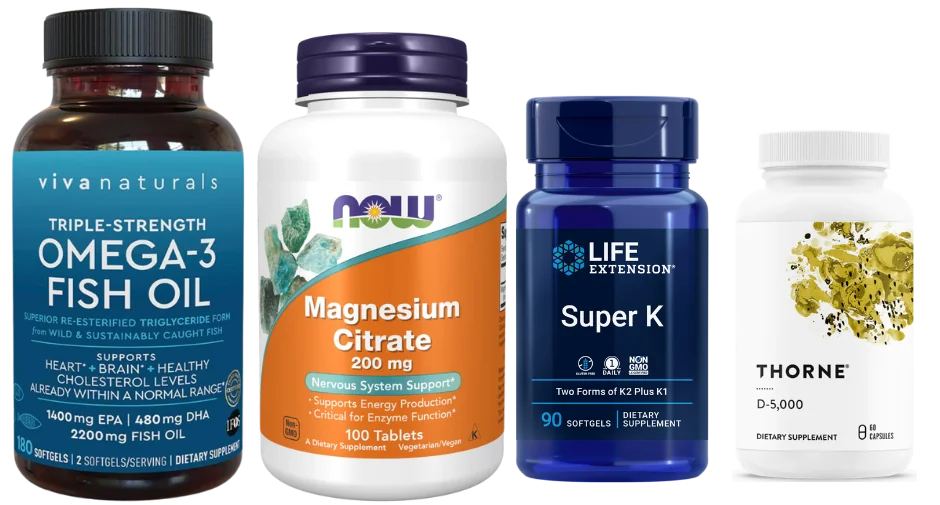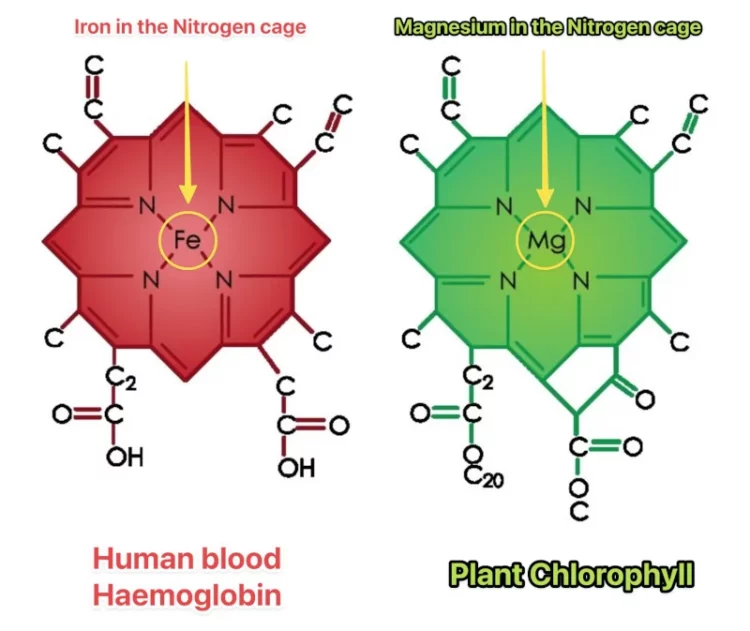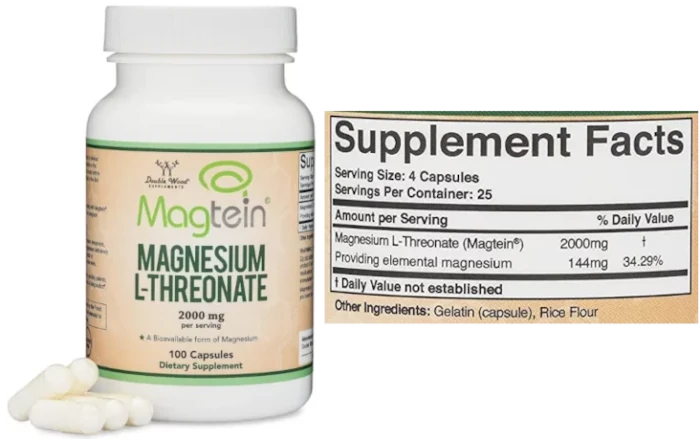If you’ve visited this site before, you’ll know we’ve covered the supplement routines of several health influencers.
You’ll also be familiar with the sheer quantity of supplements many of them take!
Whilst they may not agree on everything, we can confidently say that there are 4 supplements the majority of them take daily.

These supplements are taken by:
- Andrew Huberman, Rhonda Patrick, Peter Attia, Joe Rogan and Bryan Johnson
And what are these supplements? Specifically:
- Magnesium
- Vitamin D
- Vitamin K2
- Omega-3 Fatty Acids
In this article, we’ll break down these four supplements and the science behind them.

Magnesium
Magnesium is a mineral crucial for the health of our bones, muscles, nerves, and blood sugar regulation. It is involved in over 600 enzymatic reactions, including protein synthesis and energy metabolism[1].
However, estimates show that nearly half of the US population (48%) don’t consume enough magnesium in their diets[2].
Magnesium deficiency could lead to a wide array of health problems, including high blood pressure, type 2 diabetes, metabolic syndrome, asthma, osteoporosis, migraines, colon cancer, and sudden cardiac death[3].
Magnesium can naturally be found in foods like:
- Leafy greens (spinach, kale, collard greens, etc.)
- Nuts and seeds (almonds, cashews, pumpkin seeds, etc.)
- Whole grains (brown rice, oats, quinoa, whole wheat bread, etc.)
- Legumes (peas, lentils, black beans, etc.)
- Fish (mackerel, salmon, halibut)
- Further items such as bananas, avocados, dark chocolate, plain yogurt & raisins
Magnesium is a structural element of chlorophyll, which interestingly has a similar chemical structure to hemoglobin in our blood. One of the most noticeable differences is magnesium being the central element of plant chlorophyll, while iron takes that role in hemoglobin.

We mostly consume this mineral through plant-based foods. However, large-scale industrial farming has put additional pressure on soil, causing a quick magnesium depletion from the land.
Unfortunately, most fertilizers are based on nitrogen (N), phosphorus (P), and potassium (K), but not magnesium. Massive amounts of K fertilizers can make it harder for plants to absorb magnesium from the soil, contributing more to the growing deficiency of this mineral in the food chain.
In addition, food processing can significantly disrupt magnesium content. For example, around 80% of magnesium is lost in the whole process of going from wheat to flour to white bread[4].
The combined effects of modern farming and manufacturing result in lower magnesium intake, which can contribute to various health problems, as seen in the image below.
The Recommended Daily Allowance (RDA) for magnesium varies with age. According to the National Institute of Health (NIH), healthy adult men should consume 400-420 mg of magnesium, while females should aim for 310-320 mg daily. We should also mention that the RDA changes for pregnant women.
However, not all magnesium supplements are created equal. Your body absorbs some forms more easily than others, which makes them more suitable for certain health goals.
Some of the common types of magnesium supplements include:
- Citrate, glycinate, oxide, malate and L-threonate
Andrew Huberman prefers using magnesium L-Threonate for sleep. Still, he states that glycinate is also effective because both forms can cross the blood-brain barrier (Discover other supplements used by Andrew Huberman).
Peter Attia often recommends (lower-absorbing) citrate and oxide forms for bowel function, and better-absorbing chloride forms for those who experience an upset stomach from magnesium supplementation.
Just like Huberman, Peter Attia also uses magnesium L-Threonate before bed. (Read his supplement list here).
At the same time Rhonda Patrick prefers getting most of her magnesium from the diet, while supplementing a lower amount with the glycinate form (Discover Rhonda Patrick’s full supplement list here).
However, in her May 2022 interview with Huberman, she briefly mentioned using Magnesi-Om, a blend of gluconate, acetyl taurate, and citrate forms, coupled with L-theanine.
Magnesium glycinate is a favorable source, and reputable brands include:
| Product | Capsules | Price | Cost per 100 mg* |
| Double Wood – Magnesium Glycinate | 180 x 60 mg | $17 with coupon | $0.15 |
| NOW – Magnesium Glycinate | 180 x 100 mg | $18 with coupon | $0.10 |
Then, as we mentioned above, popular before bed is Magnesium L-Threonate:
| Product | Servings | Price | Cost per 100 mg* |
| DoubleWood – L-Threonate | 25x 144mg | $25 with coupon | $0.69 |
| Momentous – L-Threonate | 30x 144mg | $34 with coupon | $0.78 |
L-Threonate is typically more expensive than other magnesium sources due to it being patented and sold as “Magtein” – more info.

Vitamin D
Vitamin D has many important functions in our bodies, including the direct effect on the expression of over 1,000 different genes in our cells[5]. It’s involved in processes like cell growth, differentiation, and regulation, highlighting the significance of this vitamin.
Vitamin D is essential for healthy bones because it is necessary for active absorption of calcium in the small intestine[6]. The deficiency of vitamin D could increase the risk of fractures, especially in the older population.
Some research also suggests that this vitamin is vital in regulating inflammation and immune system response[7]. In fact, the majority of immune cells contain vitamin D receptors, and some are even able to locally convert inactive 25(OH)D3 into an active 1,25(OH)2D3 form.
Furthermore, healthy vitamin D levels are necessary for the normal functioning of cardiovascular and nervous systems[8].
Vitamin D is available in two forms: D2 (ergocalciferol) and D3 (cholecalciferol). The D2 form is mainly found in plants, but can also be manufactured synthetically. The D3 form is synthesized in the human skin from 7-dehydrocholesterol after exposure to the sun.
Unfortunately, estimates show that around 50% of the global population is affected by vitamin D insufficiency, and another one billion people worldwide suffer from vitamin D deficiency [9].
The RDA of vitamin D is 15 mcg (or 600 IU) for adults aged 19-70 and 20 mcg (800 IU) for those over 70, according to the NIH.
However, vitamin D levels can vary greatly between individuals based on skin pigmentation, geographic location, sun exposure, sunscreen usage, age, and other factors. Therefore, experts recommend that the most accurate way to establish individual needs is to do a blood test for 25-hydroxy vitamin D levels (active form).
Rhonda Patrick warns (watch the video here) that too much vitamin D can be bad for our health, which is why the best idea is to test before and after starting supplementation. That way, you can adjust the dosage and stay in the optimal range (40 and 60 ng/ml).
Vitamin D can be found in foods like:
- Fatty fish (tuna, mackerel, salmon, sardines, etc.)
- Cod liver oil
- Egg yolks
- Certain mushrooms (shitake, cremini, etc.)
- Beef liver
However, it’s difficult (verging on impossible) to meet the daily vitamin D requirements solely through diet.
(Especially if you consider that the NIH RDA of 600 IU is likely to be too little for many people during winter).
Instead, our bodies rely on UV-B light from the sun for its biosynthesis. This reliance on sunlight makes supplementation or strategic sun exposure crucial for maintaining adequate vitamin D levels.
Here are some trusted brands of vitamin D supplementation:
- Thorne 1,000 IU and 5,000 IU capsules (see 20% off coupon code)
- Jarrow 1,000 IU and 5,000 IU capsules (see 20% off coupon code)

Vitamin K2
Vitamin K is an essential fat-soluble protein that helps regulate calcium in our bodies by activating specific proteins (osteocalcin) to help incorporate this mineral into our skeletal system[10].
It also stimulates the matrix-Gla proteins (MGP) to prevent calcium buildup in the circulatory system and smooth muscle walls. In addition, vitamin K is needed for prothrombin functioning, a protein essential for preventing blood clotting.
Vitamin K comes in 2 different forms: K1 (phylloquinone) and K2 (menaquinone).
When ingested, these two forms act differently. K1 is transported to the liver, where it is needed to synthesize proteins important for blood clotting. When the task is completed successfully, any excess K1 is used to support calcium transport throughout the body.
In comparison, the K2 form isn’t prioritized in the liver but transported to bones, arteries, and other tissues. It reduces vascular calcification, lowering the risk of peripheral arterial disease[11].
(possibly use this picture? – https://www.researchgate.net/figure/A-Chemical-structures-of-vitamin-K1-vitamin-K2-and-pro-vitamin-K3-menadione-B_fig1_323899804_
Insufficient vitamin K consumption is associated with an increased risk of cardiovascular disease[12].
Interestingly, a higher intake of K2 is associated with a lower risk of coronary heart disease, while no such link is observed with K1[13].
The K1 form can naturally be found in plants, while K2 is mostly in fermented foods. Unfortunately, fermented foods aren’t that common in the Western diet, which is why many people lack adequate K2 intake.
To consume more K1, you can eat foods like:
- Green leafy vegetables (kale, spinach, lettuce, etc.)
- Vegetable oils
- Fruits (kiwi, avocado, blueberries, etc.)
- Soybeans
K2 can be found in meat, dairy, and fermented foods.
The National Institute of Health recommends an adequate intake (AI) of 90 mcg for women and 120 mcg for men. However, they don’t state which form is preferred (K1 or K2).
Health influencers prefer supplementing with vitamin K2, as it appears to have a greater bioavailability. There are two available forms of K2: MK4 & MK7.
It appears that MK7 has a longer half-life and greater bioavailability, but MK4 is more studied. Interestingly, some research has found that supplementation with MK4 doesn’t contribute to overall vitamin K status, while MK7 does[14].
Reputable brands of vitamin K2 include:
- Life Extension K2 MK-7 – 45 mcg
- Life Extension – Super K – K2 MK-4 1,000 mcg / K2 MK-7 100 mcg

Omega-3 Fatty Acids
Omega-3s are a type of essential fatty acids, specifically polyunsaturated fats. The three prominent forms of omega-3s include alpha-linolenic acid (ALA), eicosapentaenoic acid (EPA), and docosahexaenoic acid (DHA).
EPA is known for its anti-inflammatory properties and heart health benefits, while DHA is crucial for brain and eye health, particularly during development.
Omega-3s are also important for skin health, joint health, and inflammation control.
ALA can be converted into EPA and DHA in the liver, but the process is not really efficient. Estimates show that between 0.2% and 6% of ALA is converted to EPA[15]. ALA to DHA is converted at a similar rate (0.13% to 6%). However, it’s interesting that the number drops to 0.05% or less in men, showing that men may need EPA and DHA supplements more than women.
So, why are those numbers important?
It’s because EPA and DHA can be found in fish and fish oil, while ALA is found in flaxseeds, soybeans, pumpkin seeds, tofu, walnuts, and vegetable oils. As a result, vegans and vegetarians mostly rely on ALA for their intake of EPA and DHA. However, since the conversion isn’t very efficient, vegans and vegetarians have lower levels of these omega-3s compared to people who eat fish[16].
But vegans and vegetarians can supplement EPA and DHA with algae oil since it’s algae that actually produce omega-3s. Fish consume algae and plankton and incorporate these omega-3s in their bodies.
Research shows that using microalgae oil supplementation can increase the omega-3 index from 4.8 to 8.4 wt%[17]. That’s a significant improvement with a relatively low dose, which shows that microalgae supplementation is a great choice.
One of the main reasons why health influencers love supplementing with omega-3s is brain health and cognitive functioning.
Our brains are composed of nearly 60% fat, and the remaining 40% is mainly water, protein, carbohydrates, and salts[18]. That’s why fats are vital for the integrity and performance of the brain.
Both EPA and DHA are considered essential fatty acids because the body cannot produce them on its own, and we must obtain them from dietary sources or supplements.
While most of us get enough omega-6s, unless you are eating a lot of fatty fish, the chances are you are not consuming enough omega-3s. That’s the reason why health influencers like Peter Attia, Rhonda Patrick, Andrew Huberman, Joe Rogan, and David Sinclair all take omega-3 supplements.
In fact, Attia states that his patients almost always need EPA and DHA supplements.
The NIH recommends an adequate intake of 1.6g for men and 1.1g for women daily. However, keep in mind that these values are established for ALA consumption, and there are no specific intake recommendations for EPA and DHA.
Some reputable brands of omega-3 supplements include:
| Name | Price | Flavored? | Quantity | EPA/DHA | Total Oxidation* | Heavy Metals* | IFOS Test |
| Viva Naturals Triple Strength | $22 with coupon | Unflavored | 90 soft gels | 773 / 269 mg | 7.39 | Passed | Link |
| Carlson Maximum Omega 2000 | $29 with coupon | Lemon Flavor | 60 soft gels | 668 / 284 mg | 5.04 | Passed | Link |
| Barlean’s Ideal Omega-3 | $48 with coupon | Orange | 60 soft gels | 762 / 259 mg | 3.12 | Passed | Link |
*Oxidation levels come via IFOS batch tests. Lower is better
**Heavy metals will never be zero, but “Passed” in this context means that it passed the IFOS tests and is low enough to not be of concern.

Roundup
Renowned health influencers like Andrew Huberman, Rhonda Patrick, and Peter Attia use many supplements to support and optimize their health. However, going through these extensive supplement lists can be daunting, which is why we’ve highlighted the four staples most health influencers rely on.
Further Reading
If you’d like to dig more into the individual supplement habits of the people we’ve mentioned, see:
- Andrew Huberman Supplements – Deep dive into what he takes & why
- Bryan Johnson’s Supplement List – why he takes all 40 daily (over 100 pills!)
- David Sinclair Supplements – what the Harvard anti-aging professor takes & why
- Peter Attia’s Supplements – what he takes & why
- Rhonda Patrick’s Supplements – what she takes & why


